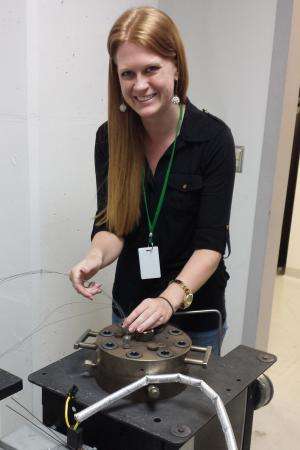Researcher studies possibility of metal snow on Venus

Is it snowing metal on Venus? Erika Kohler is trying to find out.
Kohler, a doctoral candidate in the Arkansas Center for Space and Planetary Sciences at the University of Arkansas, returned to campus last month after a summer-long fellowship at NASA's Goddard Space Flight Center in Maryland, where she performed experiments in the facility's pressure chamber to simulate Venusian conditions.
"My dissertation is focusing on metal condensates in planetary atmospheres," said Kohler, who is the only student in the Space and Planetary Sciences Center currently researching Venus. "I have been primarily looking at the stability of materials on Venus and determining what can exist at certain altitudes. I'm finding that there are different forms of iron compounds or mercury compounds that can exist at these conditions."
Venus, the second planet from the sun, is both the closest planet to Earth and the planet closest in size to Earth. But the conditions on the planet are radically different than ours. The average daily temperature is 860 degrees Fahrenheit, for instance. And the atmosphere is so dense that there are only a handful of actual photographs of the Venusian surface; most images of Venus are created through radar imaging.
"If you look through a telescope at Mars, you are seeing the Martian surface," Kohler said. "If you are looking at Venus you are only seeing clouds, not the surface. Through radar imaging, scientists have determined that there are areas on the Venusian surface that appear to have a higher reflectivity than surrounding areas. They wind up being on the slopes of mountains and volcanoes, so I'm investigating whether some sort of metallic snow is causing this reflectivity. I am looking at compounds of mercury, tellurium and pyrite.
"In terms of planetary science, I am trying to answer a question that has been plaguing Venusian scientists for the past 50-odd years," she said, adding that new information about the planet is being provided by Venus Express, a project of the European Space Agency.
The space agency launched an orbiter in 2005 and since arriving at Venus in 2006 it has been continuously sending back science data from its polar orbit around Venus. Equipped with seven scientific instruments, the main objective of the mission is the long-term observation of the Venusian atmosphere.
Back on Earth, Kohler's research on the stability of compounds under extreme conditions will also provide information that can be used by physicists, engineers and nanotechnologists, she said.
Provided by University of Arkansas





















